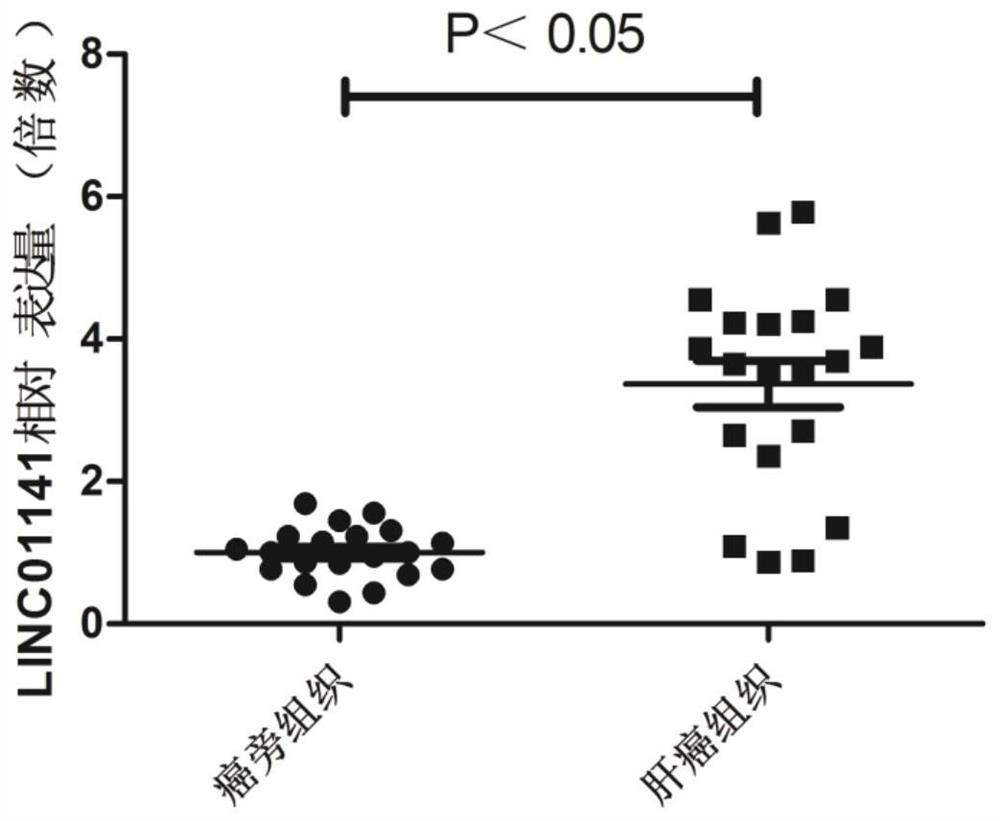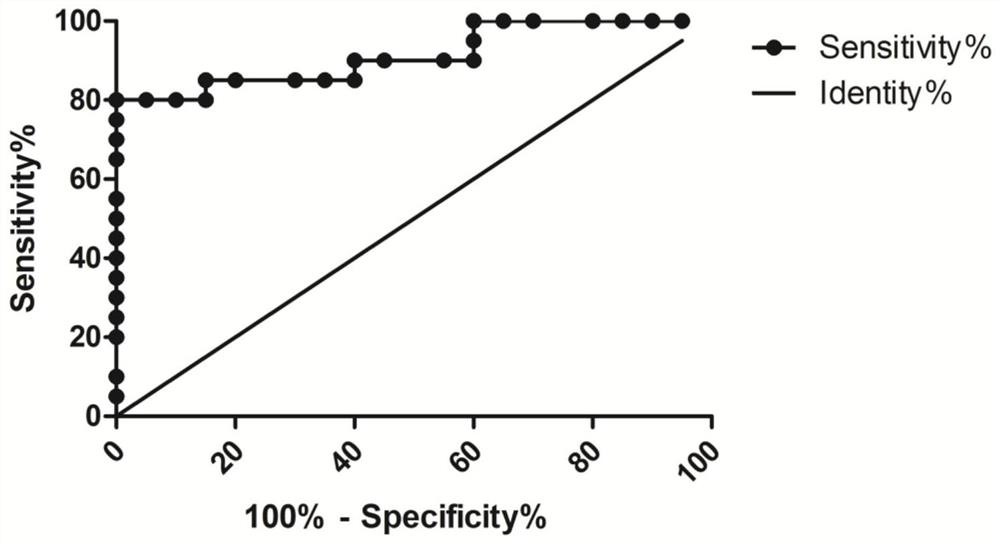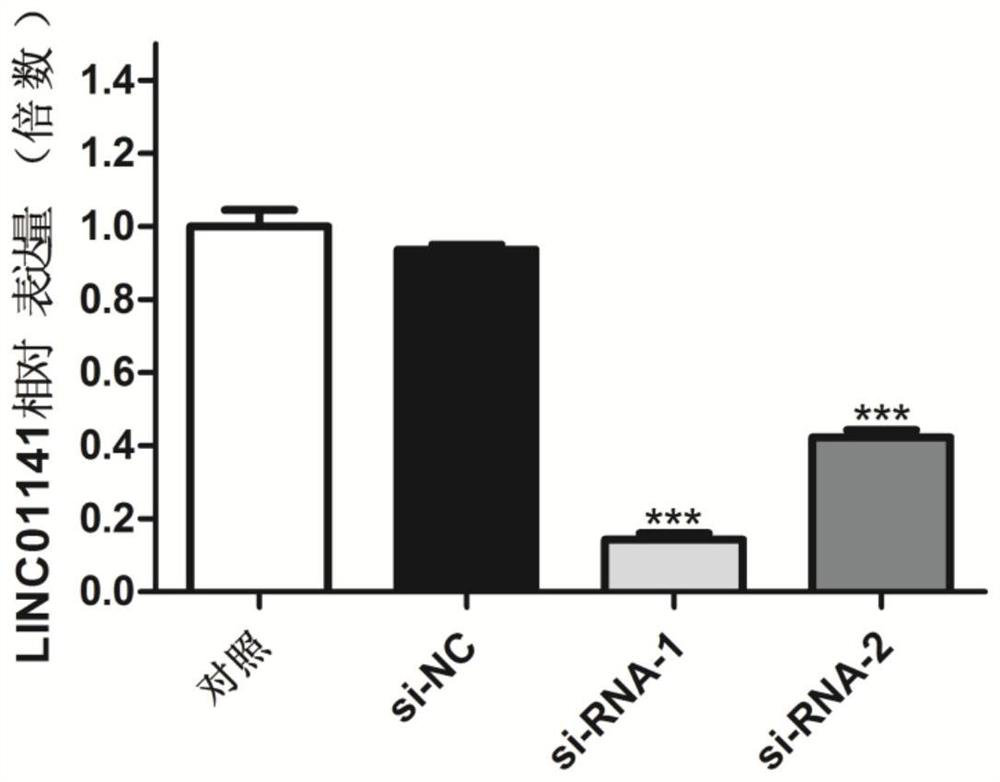Application of long-chain non-coding RNA LINC01141 in preparation of pharmaceutical composition for treating liver cancer
A LINC01141, long-chain non-coding technology, applied in the field of biomedicine, can solve the problems of RNA forming protein and having no function, and achieve the effect of improving survival rate and excellent diagnostic value
- Summary
- Abstract
- Description
- Claims
- Application Information
AI Technical Summary
Problems solved by technology
Method used
Image
Examples
Embodiment 1
[0029] Detection of the expression of LINC01141 in liver cancer tissues and adjacent tissues
[0030] 1. Research object
[0031] A total of 20 liver cancer tissues and corresponding paracancerous tissues were selected for the experiment. The tissues were obtained from Qingdao Cancer Hospital. All tissue samples were reviewed and approved by the Hospital Ethics Committee, and all patients who obtained the tissue samples signed informed consent. The liver cancer tissue was confirmed to be liver cancer by pathological examination (when the liver cancer tissue was resected, the patient had not yet received chemotherapy, radiotherapy, etc.).
[0032] The specific specimens are as follows:
[0033]
[0034]
[0035] 2. Tissue RNA Extraction
[0036] (1) Take out the tissue sample from the -80°C refrigerator, take about 50 mg of the tissue sample and put it into a mortar, add a small amount of liquid nitrogen, and grind it quickly. After the tissue becomes soft, add a small ...
Embodiment 2
[0080] Knockdown of the LINC01141 gene
[0081] 1. siRNA design
[0082] si-RNA-1
[0083] 5'‐AUUUUGCAGAUCUAUCAUCCU‐3' (SEQ ID NO.6)
[0084] 5'-GAUGAUAGAUCUGCAAAAUUC-3' (SEQ ID NO.7)
[0085] si-RNA-2
[0086] 5'‐AUCAAGUAUCUAUAUGUGCCA‐3' (SEQ ID NO.8)
[0087] 5'-GCACAUAUAGAUACUUGAUAC-3' (SEQ ID NO.9)
[0088] si-RNA-1 and si-RNA-2 were synthesized by Shanghai Gemma Company, and si-NC was provided by the company.
[0089] 2. Cell culture
[0090] Human liver cancer cells HepG2 were cultured in high-glucose DMEM medium (10% fetal bovine serum), culture conditions: cell constant temperature incubator at 37°C, 5% CO 2 .
[0091] 3. siRNA transfection
[0092] (1) The day before transfection, 2×10 5 HepG2 cells were seeded on 6-well cell culture plates at 37°C, 5% CO 2 After culturing in the incubator for 24 hours, the cells were transfected according to the instructions of Lipofectamine 2000;
[0093] (2) The experimental groups were divided into control group (empty...
Embodiment 3
[0103] 1. Cell Proliferation Experiment
[0104] (1) Divide 5×10 3 HepG2 cells transfected with si-NC and si-RNA-1 were inoculated in a 96-well plate, 90 μl per well, with 3 replicate wells for each group, placed at 37°C, 5% CO 2 cultured in a cell culture incubator;
[0105] (2) Test at 24h, 48h, and 72h respectively. When testing, add 10ul of CCK-8 detection solution to each well, and then place it in a 37°C, 5% CO2 incubator for 4 hours;
[0106] (3) Place the cell culture plate in a microplate reader, detect the absorbance at 450nm, and draw the growth curve.
[0107] 2. Results
[0108] pass Figure 4 It can be seen that after the experimental group was transfected with si-RNA-1, compared with the si-NC group, the proliferation of HepG2 cells was inhibited, and the proliferation rate was significantly reduced. At 72h, the OD value of the si-NC group was 1.09± 0.049, and the OD value of the si-RNA-1 group was 0.766±0.041, the difference was statistically significant, ...
PUM
 Login to View More
Login to View More Abstract
Description
Claims
Application Information
 Login to View More
Login to View More - R&D
- Intellectual Property
- Life Sciences
- Materials
- Tech Scout
- Unparalleled Data Quality
- Higher Quality Content
- 60% Fewer Hallucinations
Browse by: Latest US Patents, China's latest patents, Technical Efficacy Thesaurus, Application Domain, Technology Topic, Popular Technical Reports.
© 2025 PatSnap. All rights reserved.Legal|Privacy policy|Modern Slavery Act Transparency Statement|Sitemap|About US| Contact US: help@patsnap.com



